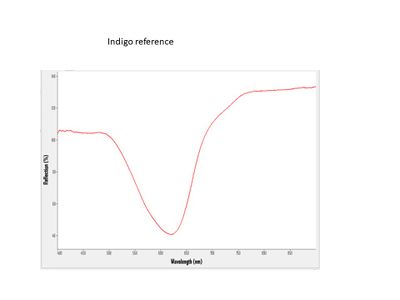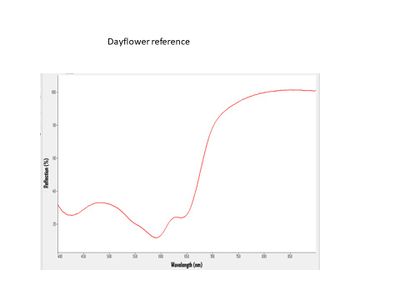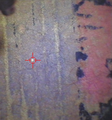Difference between revisions of "Category:Safflower: Ukiyo-e colorant"
| Line 8: | Line 8: | ||
The presence of this mixture throughout the history of color printing seems to indicate that the tone obtained by mixing dayflower blue and safflower was preferred over other possible mixtures of reds and blues to yield purple (for example indigo and madder). | The presence of this mixture throughout the history of color printing seems to indicate that the tone obtained by mixing dayflower blue and safflower was preferred over other possible mixtures of reds and blues to yield purple (for example indigo and madder). | ||
| + | = Examples of Indigo in Ukiyo-e Prints == | ||
| + | |||
| + | {|class="wikitable" style="display: inline-table;font-size:90%;text-align:center;width:15%" | ||
| + | |[[Safflower red lantern 06.809.png|200px|Red lantern (MFA 06.809)]] | ||
| + | |- | ||
| + | | | ||
| + | [[Safflower red 06.809 EEM.png|200px]]<br>[[EEM xxxxxx]] | ||
| + | |} | ||
| + | {| class="wikitable" style="display: inline-table;font-size:90%;text-align:center;width:15%" | ||
| + | |[[File:dyed indigo.jpg|200px]] | ||
| + | |- | ||
| + | | | ||
| + | [[File:Indigo FORS.JPG|200px]]<br>[[Harunobu, Beautiful Women of the Yoshiwara, Applying makeup (MFA 2006.1537.5)|Beauties of the Yoshiwara by Suzuki Harunobu]] | ||
| + | |} | ||
| + | {| class="wikitable" style="display: inline-table;font-size:90%;text-align:center;width:15%" | ||
| + | |[[File:dyed indigo.jpg|200px]] | ||
| + | |- | ||
| + | | | ||
| + | [[File:Indigo FORS.JPG|200px]]<br>[[Harunobu, Beautiful Women of the Yoshiwara, Applying makeup (MFA 2006.1537.5)|Beauties of the Yoshiwara by Suzuki Harunobu]] | ||
| + | |} | ||
| + | {| class="wikitable" style="display: inline-table;font-size:90%;text-align:center;width:15%" | ||
| + | |[[File:dyed indigo.jpg|200px]] | ||
| + | |- | ||
| + | | | ||
| + | [[File:Indigo FORS.JPG|200px]]<br>[[Harunobu, Beautiful Women of the Yoshiwara, Applying makeup (MFA 2006.1537.5)|Beauties of the Yoshiwara by Suzuki Harunobu]] | ||
| + | |} | ||
| + | {| class="wikitable" style="display: inline-table;font-size:90%;text-align:center;width:15%" | ||
| + | |[[File:dyed indigo.jpg|200px]] | ||
| + | |- | ||
| + | | | ||
| + | [[File:Indigo FORS.JPG|200px]]<br>[[Harunobu, Beautiful Women of the Yoshiwara, Applying makeup (MFA 2006.1537.5)|Beauties of the Yoshiwara by Suzuki Harunobu]] | ||
| + | |} | ||
| + | |||
| + | == Analysis == | ||
| + | Fiber optic reflectance spectroscopy (FORS) can easily identify the three blues: indigo, dayflower, and Prussian blue. | ||
| + | <gallery mode=packed heights=200px style="text-align:left"> | ||
| + | Indigo FORS.JPG|FORS spectrum of Indigo reference | ||
| + | Dayflower FORS.JPG|FORS spectrum of Dayflower reference | ||
| + | Indigo FORS.JPG|FORS spectrum of Prussian blue reference | ||
| + | </gallery> | ||
| + | |||
| + | ==Other Images of Safflower == | ||
<gallery> | <gallery> | ||
Safflower_plant.jpg |Safflower plant (''Carthamus tinctorius'') | Safflower_plant.jpg |Safflower plant (''Carthamus tinctorius'') | ||
| Line 17: | Line 59: | ||
== Examples == | == Examples == | ||
<gallery> | <gallery> | ||
| − | + | ||
| − | |||
| − | |||
| − | |||
| − | |||
<gallery> | <gallery> | ||
Revision as of 13:22, 13 May 2020
Description
For ukiyo-e woodblock prints, Carthamus tinctorius (safflower) was the primary red and pink colorant used consistently for all of the time periods and printing methods.
Safflower (benibana): The florets of Carthamus tinctorius (safflower) produce a wide range of colors from cherry red to pink. Native to northern India and the Near East, this popular dye plant was widely cultivated throughout Asia and Europe by the end of the 13th century. The florets are picked, then dried and crushed into a paste. The paste is washed with water to remove the non-lightfast yellow chromophors including several quinochalcones. The red colorant, primarily carthamin, is then extracted in an alkaline bath. The deepest reds are obtained through several initial washings to remove all of the water-soluble yellows.
Red regions containing safflower were usually seen as brightly fluorescent during the preliminary examination of the prints with a hand-held UV light. Thus, it was no surprise that the EEM fluorescence technique provided a unique and definitive pattern for safflower, even when it was visually observed in the print as a faded brown color. In addition to the fluorescence for the red chromophor, the pattern often contained an additional peak for the yellow chromophore that was supposedly removed in the preparation of the red colorant but often needed several washings for complete elimination.
The presence of this mixture throughout the history of color printing seems to indicate that the tone obtained by mixing dayflower blue and safflower was preferred over other possible mixtures of reds and blues to yield purple (for example indigo and madder).
Examples of Indigo in Ukiyo-e Prints =
| 200px|Red lantern (MFA 06.809) |

|

|

|

|
Analysis
Fiber optic reflectance spectroscopy (FORS) can easily identify the three blues: indigo, dayflower, and Prussian blue.
Other Images of Safflower
Examples
- Safflower over turmeric 21.9230 FORS.png
FORS
Pages in category "Safflower: Ukiyo-e colorant"
The following 55 pages are in this category, out of 55 total.
E
- Eisen, Early Winter: The Day of the Boar in the Tenth Month, from the series Customs of the Four Seasons and Children at Play, 11.25587
- Eisen, Fujieda: Kichô of the Owariya, from the series A Tôkaidô Board Game of Courtesans: Fifty-three Pairings in the Yoshiwara, 11.17946
- Eisen, Seijûrô and Onatsu; Banners of Bishamonten; from the series Amusements on the Festival Day, 11.17904
- Eisen, The Song Evening Mist at Asama Peak, on Scrap-paper Fabric with an Itchû-bushi Libretto, from the series A Modern Pine Needle Collection, 11.17878
- Eishi, Shizuka of the Shizutamaya, from the series Beauties of the Yoshiwara as Six Floral Immortals, 21.4917
- Eishi, Shizuka of the Shizutamaya, from the series Beauties of the Yoshiwara as Six Floral Immortals, 53.21
- Eizan, Kashiku of the Tsuruya, from the series Array of Beauties of the Pleasure Quarters, 11.17716
H
- Harunobu, A Young Woman in a Summer Shower, 11.19430
- Harunobu, Beautiful Women of the Yoshiwara, Combing hair (2006.1537.1)
- Harunobu, Courtesan and Kamuro Looking at the Face of a Komusô Reflected in a Mirror, 45.833
- Harunobu, Courtesan Reading a Letter by Moonlight Reflected on Snow; Parody of Son Kang, 11.19438
- Harunobu, Courtesan Riding a Carp and Reading a Letter; Parody of the Immortal Qin Gao, 06.969
- Harunobu, Kojima Bingo no Saburô Takanori, 11.19633
- Harunobu, Nishikigi of the Kanaya Lighting Incense beside a Mosquito Net, 11.16479
- Harunobu, Parody of Saigyô Hôshi: Courtesan Looking at a Screen Painting of Mount Fuji, 11.19431
- Harunobu, Poem by Saigyô Hôshi, from an untitled series of Three Evening Poems, 34.348
- Harunobu, The Sake Cup, sheet 4 of the series Marriage in Brocade Prints, the Carriage of the Virtuous Woman, known as the Marriage series, 11.19475
K
- Kiyohiro, Two Children Playing with Hobbyhorses, 11.19047
- Kiyomasu II, Actor Ogino Izaburô I as Yamagami Gennai, Acting in the Aragoto Style with the Sumikazura Wig, 11.13297
- Kiyomasu II, Actors Segawa Kikunojô I as Ochiyo; Matsushima Kichisaburô as Ochiyo's Spirit Projection, the Courtesan Tekkai Sennin; and Ichikawa Ebizô II as Mushanosuke of Ôsaka, 21.5452
- Kiyomitsu I, Actor Segawa Kikunojô II as Itsuki, 11.19020
- Kiyomitsu I, Actor Segawa Kikunojô II as Seryômura Okiku, 11.18992
- Kiyomitsu I, Actors Segawa Kikunojô II as the Courtesan Katsuragi and Ichimura Uzaemon IX as Nagoya Sanza, 45.832
- Kiyomitsu I, Actors Ôtani Hiroji III as Okabe no Rokuyata and Nakamura Sukegorô II as Inomata no Koheiroku, 46.1409
- Kiyomitsu I, Yoritomo's Hunt at the Foot of Mount Fuji, 11.19694
- Kiyonaga, A Matchmaking Meeting at a Teahouse by a Shrine, 21.5574
- Kiyonaga, Actors Matsumoto Kôshirô IV as Ukita Sakingo and Sawamura Sôjûrô III as the Ghost of Takao, with chanters Tomimoto Itsukidayû and Tomimoto Awatayû, and accompanist Sasaki Ichishirô, 11.13921
- Kiyonaga, Actors Matsumoto Kôshirô IV as Ukita Sakingo and Sawamura Sôjûrô III as the Ghost of Takao, with chanters Tomimoto Itsukidayû and Tomimoto Awatayû, and accompanist Sasaki Ichishirô, 21.5476
- Kiyonaga, Child Prodigy Minamoto no Shigeyuki Executing Calligraphy, 11.13883
- Kiyonaga, Women Visiting Enoshima, 11.21277
- Koryusai, Descending Geese at Mimeguri, from the series Fashionable Eight Views of Edo, 11.14627
- Kunisada, Actor Sawamura Tanosuke II, from the series Actor Rebuses, 11.42324
- Kuniyoshi, (Actor Ichikawa Ebizô V as) Inuyama Dôsetsu, from the series The Lives of Eight Brave and Loyal Dog Heroes, 11.28841
- Kuniyoshi, Hosokute: Horikoshi Dairyô, from the series Sixty-nine Stations of the Kisokaidô Road, 11.28766
M
S
- Kiyonobu I, Actor Ôtani Hiroji I as the Candy-seller Kokusen-ya, 11.13165
- Kiyotada I, Actors Sanjô Kantarô II and Ichimura Takenojô IV, 11.13273
- Sharaku, Actors Ichikawa Komazô III as Kameya Chûbei and Nakayama Tomisaburô I as Umegawa, 21.7236
- Shigenobu I, Urashima Tarô, from the series A Set of Five Examples of Longevity, 21.9254
- Shinsai, Chapters 22–24, from the series The Tale of Genji, 11.20034
- Shunkō, Actors Ichikawa Danjûrô V as Fukurokuju, Iwai Hanshirô IV as Ryûyô Dôji, and Sawamura Sôjûrô III as Shin'yô Dôji, 11.14971
- Shunkō, Actors Nakamura Nakazô I and Ôtani Hiroji III, 11.2014
- Shunman, Mandarin Ducks and Iris, from the series Series of Seven Bird-and-Flower Prints for the Fuyô Circle of Kanuma in Shimotsuke Province, 21.9226
- Shunshō, Actor Segawa Kikunojô III as Shirokiya Okoma, from the series Fans of the East, 11.14871
T
- TEST-Utamaro I, Women Overnight Guests, a Triptych, 21.6328-30
- TEST-Utamaro I, Women Overnight Guests, left panel of triptych, 21.6328
- Toyokuni, Actor Arashi Kitsusaburô I as the Monkey Trainer Yojirô, in the Horikawa Scene of the Play Oshun and Denbei, 11.30331
- Toyonobu, Rain in the Fifth Month, 11.19048
- Toyonobu, Young Couple Burning Maple Leaves to Heat Sake, 11.19676
U
- Utamaro I, A Yoshiwara Triptych, 11.14191
- Utamaro I, Courtesan Asajiu of the Daimonjiya and Nanatsu-ume Sake by Momenya, from the series Aristocrats of Sake Compared to Courtesans of Six Selected Houses, 11.14267
- Utamaro I, The Geisha Ogie Matsuzô, Mine, and Ito, 11.14373
- Utamaro I, The Heron Maiden from series An Array of Dancing Girls of the Present Day, 11.14364
























